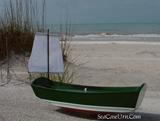

SeaCase™
Green Biodegradable Urn
What is Biodegradable? The SeaCase urn is a more naturally decomposing product than most other ‘biodegradable’ urns on the market. Most water urns today are made of a paper product that is engineered to fall apart quickly. In a matter of hours, it is diluted into the environment and there is little trace of it having ever been around. That serves well, and perhaps someday, SeaCase will offer such a noble product as well.
Our thinking on biodegradation is more along the lines of what happens to a tree when it dies in the forest. It can take time for a tree to completely disappear in the natural setting, but as it does it is contributing something to the surroundings.
Here in Florida and perhaps around the world, that dead and decaying tree is a source of food, providing insects and fungi for consumption. It provides shelter and nesting for many birds like the woodpeckers and American Bald Eagle. We believe the importance of a dead tree is far too under rated and people cut them down and remove them when we believe they should remain natural if possible.
When we designed SeaCase, we intended it to be used in the Ocean, though it is not limited to that application. The shape and the style of the urn are very unique, and we have plans for more. It could have been made from plastic or fiberglass to keep it cheaper, but that does not fit with our thinking. Like the forest, the ocean is a breathing environment that lives on death. The reef you see is built upon the old corals and deposits left from previous generations of creatures. Of course, there are man made formations as well. Often times, concerned environmental groups and State agencies will specifically engineer artificial reefs to provide extra habitat for a large host of creatures. SeaCase urn is somewhat like that, but on a smaller level.
The urn is ballasted to sink to the bottom and remain there. The thin plywood will begin to delaminate and expose wood to the surrounding life. Specific bacteria and organisms will be attracted to the wood for food source. Sponges and algae will attach to the distorted pieces. Small fish and crustaceans will find shelter. The process is a natural one. There are many microbial actions occurring at many levels also. We really do not know how long it will take to completely integrate with the environment because conditions vary, but it will not happen in two days.
Our point is that a SeaCase Urn is a contributor to life in its death. We give something back in an intelligent way to promote growth, if but only for a little while. We believe you also think in those terms.
On a little more technical side, the paint used on the typical SeaCase is not considered a "low VOC" paint. It does comply with the U. S. EPA national regulations for our region on <450 g/l. The Maximum Incremental Reactivity (MIR) value is also within national EPA guidelines. So far, our work with a truly low VOC finish has been somewhat discouraging. People want something that looks nice, and the current products are just a bit sketchy looking and hard to get a really nice finished product. We will not give up in our quest to be the best. None the less, water action as well as salt abrasion will break down the wooden Urn and paint in a natural fashion. We feel at ease and hope you do too.
If you have any other questions or concerns, please feel free to ask us. We are happy to converse with you. Our current contact is listed on the web.